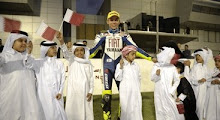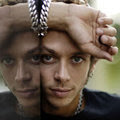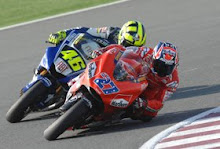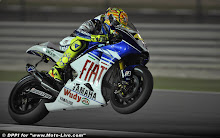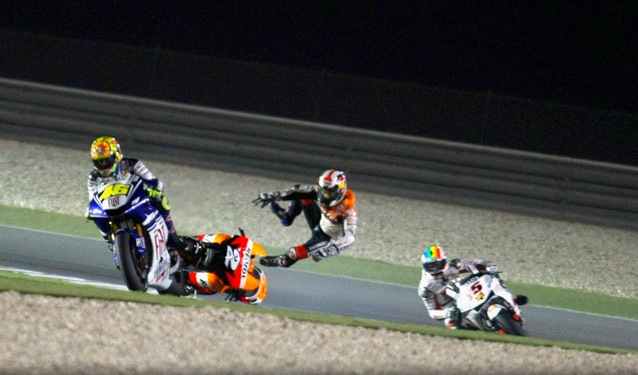
The 2006 MotoGP season started off with Rossi, once again, being the favorite to take the Championship, but he had trouble in the first half of the season. Rossi finished 14th in Jerez, making an amazing comeback after Toni Elias pushed him at the very first corner, and had a pair of DNFs in Shanghai and Le Mans due to tyre and electronic problems respectively. Nicky Hayden held the points lead throughout most of the season, but Rossi was slowly working his way up the points ladder. It wasn't until Motegi when Rossi finally grabbed 2nd in the points race behind Hayden. In the Portuguese Grand Prix, the second to last race of the season, Hayden was taken out by his teammate, Dani Pedrosa, and did not finish the race. This led to Rossi taking the points lead with only one race left in the season. Rossi crashed early in Valencia, the last race, and Hayden went on to win the 2006 MotoGP Championship. Rossi finished the season in 2nd place.
Valentino Rossi returned to MotoGP for the 2007 season riding the new Yamaha YZR-M1 800 cc. In the first race in Qatar he came second to Casey Stoner on the Ducati Desmosedici. In the second round of the season Rossi won the Race with Dani Pedrosa in second place and Colin Edwards in third giving both Yamaha riders podiums. Casey Stoner returned to winning ways in the third and fourth races of the season at the Turkish and Chinese grand prix on his extremely quick Ducati, which has enjoyed a top speed advantage over the rest of the field. Another reason for Stoner's consistency during the 2007 season in comparison with Rossi's mixed results is the advantage Ducati's tyre supplier, Bridgestone, appears to have over its rival, Michelin, who supply tyres

for Rossi's factory Yamaha.
Rossi's lowly 10th position at Turkey was put down to a defective tyre and while he managed to bounce back to a second place on the podium at China, a poor tyre recommendation from Michelin was blamed for his 6th place finish in the wet French grand prix at Le Mans. Bridgestone riders took all 3 places on the podium at the French tyre giant's home race, and Rossi went on the record to say that Michelin must urgently address various weaknesses. Indeed it seemed they paid heed to their wake up call when Rossi cruised to victory at his home race, the Italian grand prix at Mugello, ahead of Dani Pedrosa, also Michelin-shod on his factory Honda. Championship leader Casey Stoner was beaten to the last podium place at Mugello by Brazilian veteran Alex Barros on a satellite Ducati with Bridgestone tyres.
Rossi's grip on the championship loosened slightly at Catalunya and Donington, finishing second and fourth respectively to winner Casey Stoner, however the Assen race was won by Rossi who charged through the field from 11th on the grid after a poor wet qualifying session to challenge and eventually beat Casey Stoner to the chequered flag by 1.5 seconds. At the half-way point of the 2007 season Rossi was the closest challenger to Casey Stoner's title aspirations, trailing by 21 world championship points. In the month of June, commonly called "Rossi's month" with races consisting of Mugello, Catalunya, Donnington Park and Assen, both Valentino Rossi and Casey Stoner have scored 83 points each; 2 x 1st place, 1 x 2nd place and 1 x 4th place. This has been done in conditions favourable to the Italian manufacturer and in some cases left Rossi on the fourth row with a point to prove.
Sachsenring saw a disastrous performance from the Italian. After qualifying fourth on the grid, whilst Stoner took pole, Rossi had to use race day to his advantage. Come Sunday, Rossi lined up with a fever of 102 degrees and dropped down to 8th by the end of the first lap. A pass on Randy De Puniet at the tight Omega corner saw Rossi lose the front, catch it then lose it completely and skid off into the gravel where his right hand clip on was damaged leaving him out of the race on lap 6. Luckily problems for Bridgestone in the blistering heat saw Stoner finish 5th stretching his championship lead by 11 points to 32 ahead of "The Doctor". A visit to Laguna Seca for the USGP, Rossi finished 4th place behind Stoner, Vermeulen, and Melandri respectively.
The end to the summer break in the 2007 season landed the MotoGP paddock at Brno, with various new changes to the Fiat Yamaha. Qualifying 6th for the race start on Sunday morning after struggling in free practice, Rossi spent his rear Michelin early on in the race chasing Capirossi to make it up to 5th. Eventually tyre issues got the best of the 7 times world champion and Rossi crossed the finish line in 7th, a whole 22 seconds behind 1st place man Casey Stoner. This now leaves Rossi 60 points behind the Championship leader with only 150 points up for grabs.

Misano saw Rossi starting from 2nd on the grid behind Casey Stoner. An engine failure five laps in resulted in Rossi falling 85 points behind Stoner as he finished first. A start from 3rd on the grid in Estoril ended in a no holds barred race with Pedrosa as they both accelerated out of the last corner sideways for Rossi to take the race win and gain 9 points in the World Championship on Stoner who finished in third.A wet race confused the front runners at Motegi as the track dried out quickly with everybody still on wet tyres. Rossi fought his way to first and whilst in front of Melandri, put in some impressive lap times. A late bike change got the Doctor back out in second behind Capirossi, but cold intermediate tyres ended in Rossi running of the track at the end of the back straight, another pit stop put Rossi back out in 13th with nothing else to do but watch Stoner take the World Championship.

 ions
ions










